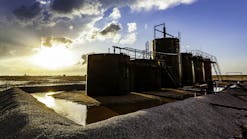Capturing CO2 and sequestering it underground is an attractive long-term option for greenhouse gas reduction, but decisions regarding it cannot be postponed if its benefits are to be maximized, according to a report by McIlvaine Company (www.mcilvainecompany.com).
McIlvaine says a coal-fired power plant that co-fires 20 percent biomass and captures 90 percent of the CO2 emissions will be a net reducer of CO2. If every plant were to achieve this capability, McIlvaine predicts the U.S. power plant emissions of CO2 would drop from 1.7 billion tons/yr to a minus 170 million tons/yr. According to McIlvaine, this combination would achieve more of a reduction in emissions than switching to other renewables such as wind and solar.
McIlvaine says co-firing biomass in coal-fired boilers has a number of advantages over separate dedicated biomass combustors. Co-firing can improve mercury capture and NOx reduction in coal-fired boilers. The energy efficiency is higher than with dedicated biomass. It also lends itself to co-generation. McIlvaine says an onsite cellulosic ethanol plant could be used to provide the biomass to the coal-fired power plant, while the coal-fired power plant provides the waste steam to the ethanol plant. Meanwhile, McIlvaine says CO2 capture for dedicated biomass plants would be more expensive, as the flue gas entering the CO2 capture system has to be very clean.
According to McIlvaine, utilities are presently engaged in selecting air pollution control equipment to retrofit to existing plants. It says, these utilities should consider either purchasing more efficient systems initially or designing the retrofit for an inexpensive later upgrade to the purity level needed for CO2 capture.
McIlvaine predicts a new ultra super-critical coal-fired power plant will create 30 percent less CO2 than an old coal-fired power plant.
McIlvaine says require technology considerations for such upgrading current plants include heat exchangers, combustion systems, coal handling and other equipment, as well as optimization software.
According to McIlvaine, if a coal plant replaced an old coal-fired boiler with a new super-critical unit now, the utility would be able to emit 30 percent less CO2 for the first 15 years and then 80 percent less CO2 for the next 15 years. Further, McIlvaine says, the reduced cost of operating a new plant plus the 30 percent fuel savings will offset the depreciation on the new plant.
Then, after 15 years, McIlvaine says the plant can add the CO2 capture system or close down the plant and replace it with a wind turbine or solar generator. McIlvaine believes such a strategy represents a low-cost option compared to various other plans based solely on wind and solar prior to the time they can be delivered in the quantity and at the cost required.
According to McIlvaine, utilities would be wise to consider CO2 capture as just one of the tools along with customer energy efficiency improvement, nuclear, solar, wind, and biomass.

